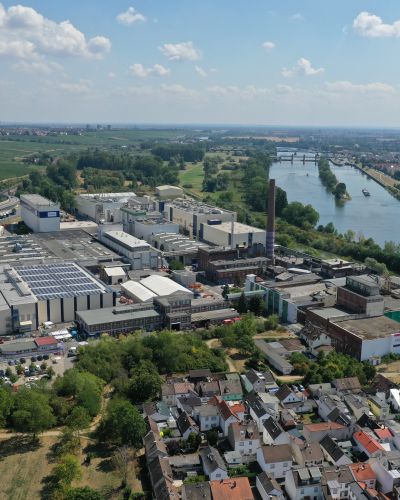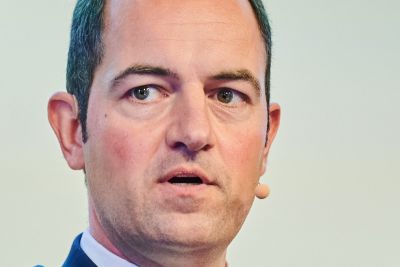Thorsten Becherer – the manager of Essity’s production facility in the Mainz-Kostheim district of Wiesbaden – is a passionate cyclist who finds it natural to use this highly sustainable, eco-friendly way of getting to work every morning. “We can all do our bit for the climate and improve our personal carbon footprints. That’s why we support a large number of small projects for our staff, take part in Germany’s community-based ‘CityCycling’ initiative, provide green electricity for recharging electric vehicles, and volunteer for clean-up days on the banks of the nearby River Main. Nevertheless, as a leading industrial enterprise that consumes a lot of energy, we know that big changes are vital. And here we have been working with the State of Hessen since the end of 2021 to revolutionize our sector”, says Becherer.

Essity in Wiesbaden: Even energy-intensive industries can be made sustainable using green hydrogen and a step-by-step approach
Many of us know global consumer goods and tissue paper manufacturer Essity through its brands such as Tempo, Tork, and Zewa. Germany is the Swedish Group’s largest European sales market with revenues of EUR 1.2 billion in 2021. Overall, the Essity´s German subsidiaries employ roughly 4,700 people. The Wiesbaden facility boasts 3 paper-making machines, 13 state-of-the-art processing lines, and 540 members of staff, making it Essity’s second-largest facility in Europe. The plant mainly transforms recycled paper into high-quality tissue products for catering, healthcare, offices, and factories: Roughly one million pallets of goods leave the site in the south of Hessen’s capital every year. At this scale, sustainability is essential, and Essity has been making progress here for years by producing cellulose from straw, launching the world’s first recycling service for paper towels, and introducing toilet paper without rolls, to give just a few examples. The aim of the company is to reduce its carbon emissions to zero.

Thorsten Becherer, Managing Director at Essity Professional Hygiene
“We are constantly searching for ways to optimize what we do. Our approach here is to start with local solutions at individual sites that we can then scale up worldwide. So, it's no coincidence that one of our largest innovations at present is being implemented in Wiesbaden: We are migrating our number one ‘energy hog’ to run on green hydrogen – and have received first-rate precision support for this from Hessen’s Ministry of Economics, Energy, Transport and Housing,” Becherer continues. The process he is talking about is hood drying — a step in paper making that uses a sort of oversized hair dryer.
Whereas it is technically possible to convert other steps in the manufacturing process to run on electricity – and hence potentially renewable energy – hood drying needs such high temperatures that this doesn’t work. To date, the process has applied natural gas. Now, Essity’s south Wiesbaden site is hosting a global first: the use of green hydrogen, which can be generated sustainably from wind power sourced from the Rhine-Main region, among others. “We are not running separate tests before switching to this new energy source – we’re transitioning live on our largest paper-making machine. This will allow us to cut carbon emissions by 11,000 tonnes a year straight away. Our goal is to have converted the entire production at our south Hessen facility by 2024 and hence to save 140,000 tonnes of CO2 a year,” the facility manager says proudly.
The support and assistance the State gave us was really excellent. The links they forged to suitable partners allowed us to focus on our technical knowledge during implementation while drawing on additional expertise from the region.
All in all, Essity is investing EUR 4 million in the pilot project. Thanks to help from the State of Hessen, the company is also receiving a grant of EUR 1.4 million from the European Regional Development Fund (ERDF). “The support and assistance the State gave us was really excellent. The links they forged to suitable partners allowed us to focus on our technical knowledge during implementation while drawing on additional expertise from the region: The local Mittelstand companies are acting as suppliers, and even start-ups can be included in these transformation processes. This network plus the advice provided on navigating the large and complex funding ecosystem are invaluable, even for a global group,” emphasizes Becherer.
The local dimension is especially important to the facility manager, and not just in the large hydrogen project. For example, a photovoltaic plant was installed on the roof of the plant’s new paper processing building back in 2019, in cooperation with a local energy cooperative. All of the green solar power produced by the plant is fed into the local grid.
“Instead of charging rent for the roof, we agreed with the cooperative members that they would use part of the sustainable electricity generated to power electric vehicle chargers in our employee parking areas – which our staff can use free of charge,” Becherer says. “Of course, that was just another small step, but it was still enough to persuade some colleagues to get an electric car. When all’s said and done, it’s combining all these different measures and having the right attitude that count: Sustainability has to be turned into a reality – and be implementable in practice – at a local level. That’s why the support we get from the State of Hessen is so valuable.”

